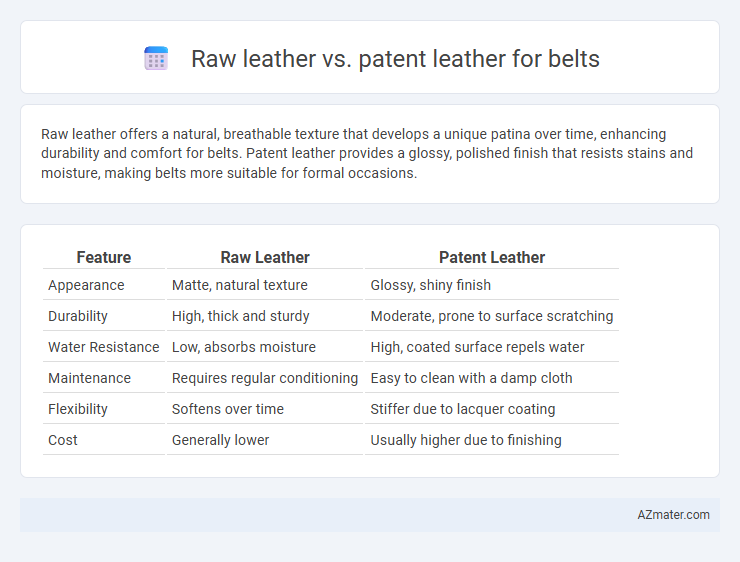Raw leather offers a natural, breathable texture that develops a unique patina over time, enhancing durability and comfort for belts. Patent leather provides a glossy, polished finish that resists stains and moisture, making belts more suitable for formal occasions.
Table of Comparison
| Feature | Raw Leather | Patent Leather |
|---|---|---|
| Appearance | Matte, natural texture | Glossy, shiny finish |
| Durability | High, thick and sturdy | Moderate, prone to surface scratching |
| Water Resistance | Low, absorbs moisture | High, coated surface repels water |
| Maintenance | Requires regular conditioning | Easy to clean with a damp cloth |
| Flexibility | Softens over time | Stiffer due to lacquer coating |
| Cost | Generally lower | Usually higher due to finishing |
Introduction to Raw Leather and Patent Leather
Raw leather, often called full-grain leather, is prized for its natural texture, durability, and ability to develop a unique patina over time, making it a popular choice for high-quality belts. Patent leather is distinguished by its glossy, smooth finish achieved through a coating process, providing a sleek and polished appearance ideal for formal belt styles. Both materials offer distinct aesthetic and practical benefits, catering to different fashion preferences and occasions.
Defining Characteristics of Raw Leather
Raw leather, known for its natural, untreated surface, offers a matte finish with a rugged texture that enhances durability and breathability. It retains the hide's original grain patterns and is highly porous, providing a unique patina over time with exposure to moisture and air. This material contrasts with the glossy, smooth surface of patent leather, which undergoes a coating process to achieve its characteristic shine.
Key Features of Patent Leather
Patent leather is characterized by its glossy, mirror-like finish achieved through a coating of lacquer or varnish, making it highly resistant to water and stains. This type of leather offers a sleek and polished appearance ideal for formal belts, maintaining a smooth surface that resists scuffing and fading over time. Unlike raw leather, patent leather requires less maintenance due to its protective coating, providing durable wear and a vibrant, long-lasting shine.
Durability: Raw Leather vs Patent Leather
Raw leather offers superior durability due to its natural fibers and resistance to cracking and wear over time, making it ideal for belts exposed to daily use. Patent leather, coated with a glossy finish, is more prone to surface scratches and may degrade faster under constant friction or moisture exposure. Choosing raw leather ensures long-lasting strength and resilience, while patent leather prioritizes appearance over prolonged durability.
Visual Appeal and Aesthetic Differences
Raw leather belts exhibit a natural, rugged texture that develops a unique patina over time, enhancing their rustic and vintage visual appeal. Patent leather belts, with their smooth, high-gloss finish, offer a polished and sophisticated look ideal for formal occasions. The contrast between the matte, organic surface of raw leather and the reflective, sleek aesthetic of patent leather defines their distinct stylistic identities.
Comfort and Wearability Comparison
Raw leather belts offer superior breathability and flexibility, enhancing all-day comfort by molding to the wearer's body over time. Patent leather belts, coated with a glossy finish, provide a slick surface that is less breathable and can feel stiffer initially, potentially reducing comfort during prolonged wear. The natural texture and softness of raw leather contribute to greater wearability, while patent leather prioritizes aesthetic appeal at the expense of comfort.
Maintenance and Care Requirements
Raw leather belts require regular conditioning and cleaning to prevent drying and cracking, as their porous surface absorbs moisture and dirt more easily. Patent leather belts, coated with a glossy finish, are more resistant to stains and moisture but need gentle wiping with a damp cloth to maintain shine and avoid surface cracks. Both types benefit from proper storage away from direct sunlight and extreme humidity to extend belt durability.
Price Point Analysis
Raw leather belts typically command a moderate price point due to the use of untreated, natural hides that require less processing, making them more affordable for consumers seeking durability and a classic look. Patent leather belts, treated with a glossy finish and additional coatings, often incur higher costs because of the intensive manufacturing process and the premium aesthetic appeal. Market analysis reveals that raw leather belts are favored in budget-conscious segments, whereas patent leather belts attract buyers prioritizing fashion and formal wear, justifying the price premium.
Best Use Cases for Each Leather Type
Raw leather offers a natural, breathable texture ideal for casual or vintage-style belts, providing durability and a rugged aesthetic suited for everyday wear and outdoor activities. Patent leather, with its glossy finish and smooth surface, is best used for formal belts, complementing dress attire and special occasions where a polished, sophisticated look is desired. Choosing between raw and patent leather depends on the context, balancing practicality with style requirements.
Final Verdict: Choosing the Right Leather for Your Belt
Raw leather belts offer a natural, durable, and breathable option that develops a unique patina over time, ideal for those seeking authenticity and longevity. Patent leather belts provide a glossy, polished finish perfect for formal occasions, but they may lack the flexibility and breathability of raw leather. Selecting the right leather depends on whether you prioritize classic durability and character or sleek, polished aesthetics for your belt.

Infographic: Raw leather vs Patent leather for Belt
 azmater.com
azmater.com